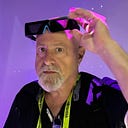Viture One XR Glasses: Practical Assisted Reality For Everyday Use
David Jiang, founder and CEO of Virture. VITURE
I first met Viture founder David Jiang at the CES in January 2022 when he gave me a private demo of his prototype glasses, which had recently raised $2.5 M on Kickstarter. When I put the glasses on, I saw the reflection of the tiny screen of a handheld Steam Deck as a 120” screen. I was looking up at it, not down at my hands. The device shipped as scheduled later that year and was recognized by Time as one of the best inventions of 2022. Soon thereafter, Virtue closed a Series A funding round totaling over $10 million led by BAI Capital and Verity Ventures, securing the financial support needed to mass-produce its flagship product, the Virtual One, and take on companies like XReal which have raised over $100M.
Upon unboxing, the Viture One XR Glasses exude a sense of simplicity with their matte black or white plastic finish. Setting them up was a breeze — simply plug them into the USB-C port of your device, adjust the diopters for personalized focus, and you’re ready to go. At just 78 grams, the Virture smartglasses are so light you barely feel them. You could wear them for hours. What I liked best was the ease of use. As soon as I pulled them out of the box, I plugged them into my iPhone 15, and it just worked, same with my other devices, an old Samsung Galaxy phone, and an Omen gaming PC.
By offloading most of the computing onto the smartphone, the Virture is versatile. It is capable of whatever your smartphone is. It is an accessory. This was not exactly the way pundits like me predicted AR devices would come into our lives. I thought the holy grail was an all-in-one, as does Meta, but the Apple Vision Pro, and Magic Leap before it, discovered they have employ a tethered external power supply.
One of the most impressive aspects of the Viture One XR Glasses is their display quality. With a resolution of 1080p per eye, the visuals are crisp and vibrant, delivering an immersive viewing experience.
The multi-function button by default switches the electrochromic film dimming of the external lenses. With this off, you can see through the glasses much as you would with ordinary sunglasses, while dimming reduces the opacity, making the content easier to view in brighter light. Still, outside you’re going to want to use the accessory shades.
Sound quality is another area where the Viture One XR Glasses excel. Equipped with built-in Harmon speakers the audio experience is spatial, immersive and engaging. Whether I was gaming or watching movies, the spatial audio added depth and realism to the overall experience. However, many users recommend the neck band, which supposedly adds a more visceral sound experience.
Double-tapping the button switches the rocker switch between volume and brightness. Triple-tapping ‘pins’ the video to a fixed location, so you can turn your head away from the screen. Long-pressing it switches between 2D and 3D mode when viewing 3D content (you need it in 3D mode for viewing Spatial Videos, for example). With the Spacewalker app you can even create multiple screens and watch 360 videos, although as with other screen reflectors, or assisted reality, glasses, this part is not as well developed. Media consumption is the thing, but the aspiration is much much greater.
Virtue has several accessories worth buying, but it raises the price considerably. The audio neckband for Android, which is widely recommended, is $179, and the Mobile Dock for gaming is $129. If you don’t have an iPhone15, or a recent Mac, you’re going to need an $29 adapter.
Despite its strengths, the Viture One XR Glasses are not without their limitations. Some users may find the field of view to be modest, and occasional blurriness may detract from the viewing experience. However, these issues were relatively minor and did not significantly impact my overall enjoyment of the glasses. This emerging category of Assisted Reality is a crowded one, too, with competitive offerings from XReal ($439), Rokid ($499), TCL Nextwear ($349), and Ray-Neo ($378).
I may be the last writer to review the Viture One XR Glasses, but I am glad I did. While not quite crisp enough for all-day productivity, they are a plug and play solution for on-the-go video and video games and, until they make me return this demo unit, I may use it to watch a few Dodgers games while taking in the sun by the pool.
